#bosch-integral
Text





Here are my personal Top 5 photographs 2023 in memorial of the
Gray-Card’s Year End Top 5 Photo Extravaganza | uwhe-arts
Many thanks to —> luxlit.tumblr.com for hosting the beautiful Year End Top 5 Extravaganza Tradition!
Thank you for all!!! I wish you all a happy new year! May each day of the New Year be filled with contentment, opportunities, peace, abundance and health!
Hugs and Chers!
Previous top five's:
2022 / 2021 / 2020 / 2019 / 2018 / 2017 / 2016
#in memory of gray gard's year end Top 5 photo extravaganza#luxlit#Top 5#Top 5 Photo Extravaganza#photographers on tumblr#gray card#2023#photoset#TOP Five#year end selection#photography#starlight2travel#bosch-integral#camera-raw#lensblr#pws#photosworthseeing#maureen2musings#landscapeexposurenetwork#imiging#j-k-i-ng#original creators#original photographers#explore#selection#curators on tumblr#uwhearts#personal top 5#uwhe-arts#ponderation
243 notes
·
View notes
Photo

Kitchen Enclosed
Small transitional l-shaped porcelain tile enclosed kitchen design idea with raised-panel cabinets, white cabinets, quartz countertops, a brown backsplash, mosaic tile, and stainless steel appliances.
1 note
·
View note
Photo

Pantry San Francisco
Mid-sized tuscan single-wall light wood floor kitchen pantry photo with a single-bowl sink, raised-panel cabinets, yellow cabinets, granite countertops, yellow backsplash, colored appliances and no island
#hardwood flooring#madura gold granite#integrated bosch dishwasher#amanna paneled refrigerator#custom painted cabinets#pewter hardware.
0 notes
Link
0 notes
Photo


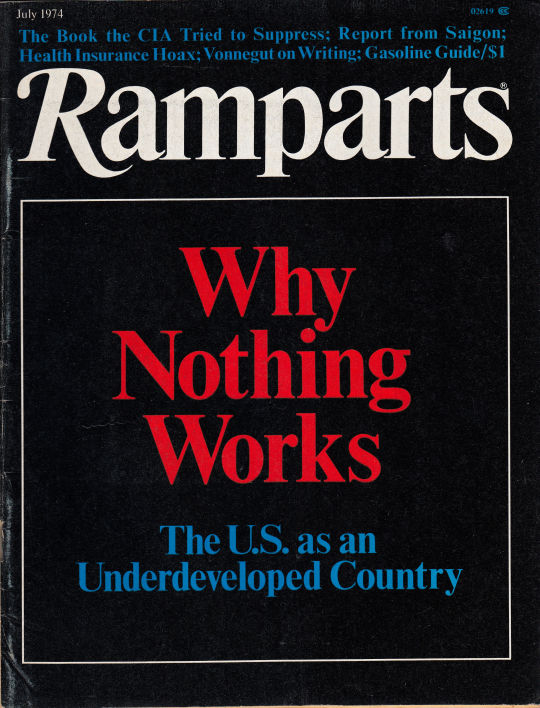



This series is about something, maybe assassination, identity, and mass politics. The previous part, Part 3, is here.
Almost nobody remembers Ramparts anymore. The 1962-1975 magazine was a mainstay on newsstands with its glossy covers and sensationalism, and yet inside was a type of investigative muckracking journalism more in common with Mother Jones or Counterpunch (both of whom it helped spawn) than the tabloids it stood with. Its story is an effusive narrative with a star-studded cast, featuring early works from virtually everybody well known on the left today as well as people famous for writing in its heyday who have fallen by the wayside. It’s really not a tale that can be told as a one paragraph pitch, because it happens to have a load of complexity. Ramparts reflected an America in transition between an old idea of multiculturalism as a progressive force to put Protestants, Catholics, and Jews onto an equal footing into a new one to negotiate whether black people and other minorities would be integrated into the management of America’s global empire, work together to overthrow it, or be mutilated by an apartheid regime in freefall. It also showcases the role of insurgency, especially symbolism, and counterinsurgency, especially intelligence, in the management of that global empire at home and abroad.
The magazine began the way many failed dreams do: a moralizing Catholic who inherited a small fortune from his parents. Real estate lawyer Edward Michael Keating had been born to a poor woman and grew up in orphanages when he was suddenly adopted by a millionaire who he’d always suspected was his biological father, too ashamed to keep him until he was too ashamed to not. He married Helen English, another millionaire whose parents died young which meant he got their money. Flush with cash and guilt, he decided he would found a left wing Catholic magazine. America was dominated by a conservative bloc of Catholics: the most powerful American Catholic was Cardinal Spellman of New York. He had agitated for an American invasion since the French defeat in 1954 and worked with the CIA to defeat Juan Bosch in the Dominican Republic in 1965. Keating was an idealist. He published Ramparts chock-full of the ramblings of every heterodox Catholic in the country (an early review compared it to a middle school girls’ poetry rag), but also with reports from prominent liberal Catholics like Thomas Merton, a hippie monk who wanted to bring Buddhist practices into the church, and John Howard Griffin, a white guy who painted himself black and toured the south as an undercover journalist. Their advocacy of black civil rights kept them from mainstream American Catholicism, but they found a voice in Keating.

This attracted left wing radicals to a magazine which had a rich donor willing to back any odd idea they’d have, who was more dedicated to exposing America’s hypocrisies than in dealing with his own. Perhaps the most important figure here was Warren Hinckle, a Catholic who got on Keating’s good side by being devil’s advocate in print to prominent Catholic figures and who brought credence by having worked for an actual newspaper, the San Francisco Chronicle. He had done a stint in Oakland and learned how the police treated black people (”the loss of a white life had more news value than the loss of a black life”). Hinckle was a hard drinker who loved thumbing his nose at every piety he could, which made him an antagonist of everything from the national intelligence establishment to good manners. However, he still attended mass weekly, the same as virtually every lapsed Catholic did in those days because the center of virtually all American social life at the time was at places of worship, something definitively not true nowadays.
Hinckle’s tactics at selling magazines were what made him permanent as the editor. When German playwright Rolf Hochhuth wrote a play criticizing Pope Pius XII’s role in the Holocaust, Keating and Hinckle both thought it was shit privately. However, Hinckle overheard famed muckracking journalist I.F. Stone’s sister Judy on the phone unable to sell an interview with Hochhuth, he convinced Keating to run it alongside a defense of the play. Moreover, Hinckle decided to promote it with a press conference at the Waldorf Astoria in New York. He phoned every newspaper and magazine in the city to promote it including Bedside Nurse, Detergent Age, Professional Barber, and the Jewish Braille Review, offering free danishes and bloody marys. When the press came and Keating began to orate, both were enthralled at the attention they received. Hinckle followed this up with a story purported to name the murderers of 3 civil rights workers in Alabama that never emerged, a story featuring graphic pictures of white police beating black men during Harlem riots, and a picture of swear words under an image of Christ. Merton cautioned the two over the sensationalism, but they continued to publish their work because it sold and got them attention.

It also got them funders. Jessica Mitford, the heir of a British lord who had joined the American Communist Party, was one of many rich left wing ideologues who liked the mag’s bent and could use some of the ad space (her own story is pretty incredible). Others were businessmen for whom the bargain bin rate outweighed the salaciousness. Hinckle’s prowess at negotiations always made it seem like he was doing the investor a favour, despite them having to sign a waiver indicating sound mind after seeing the accounting sheets. Income never came close to outweighing expenses given the predilection for expensive stunts, the need to come up with in-depth investigative journalism, or the sheer amount of expenses Hinckle and others were willing to charge. With creative accounting, however, Ramparts never had to resort to printing on cheap “butcher paper” without colour illustrations like other leftist mags until the end of the 60s.
This marked the shift away from explicit Catholicism to leftism, shifting some control out of Keating’s hands and allowing them to hire white people from other religions. Two key hires at the end of 64 and beginning of 65 were Jews. Dugald Stermer was a graphic designer with no leftist credentials to speak of. He was given control of the entire magazine’s look every month and designed most of the covers himself, and his talent became much of the reason for Ramparts’ continued success. For decades after, magazines like Rolling Stone, Mother Jones, and the Nation based their work on his. The second was Robert Scheer. A New York red diaper baby, his formative years were spent in CCNY arguing with other Jews about left wing economics. Bearded and long-haired before it was cool, his academic career was derailed by a trip to Cuba where he met with Che, killing his job at Princeton and forcing him into the ghettos of left wing journalism. Scheer’s first article with Ramparts was in January 1965, in an issue focused on the Vietnam War. Keating had managed to get the magazine an interview with his old college roommate, a senator from Idaho who had come out against the war named Frank Church (later of the Church Committee). Scheer critiqued the work of prominent Catholic supporter of the war Thomas Dooley with his own experiences, having travelled to Vietnam in 63. His article had come as a result of his girlfriend meeting Hinckle’s wife. Before he could be hired, a sitdown was necessary between Keating and Scheer. It occurred at a restaurant where the waitresses were topless. Keating, ever the moral conscience of Ramparts, did not like the experience, saying “It didn’t seem safe to serve hot food that way“. Scheer rose quickly because he was one of the few people on the staff who had foreign policy knowledge and was willing to fly to the places he discussed to do research. By October, he was “Foreign Editor”, his hands on every Vietnam War piece published. He also had other beats: in 1966, during the Reagan campaign for California governor, he was tasked with getting an in person interview. Scheer fell asleep in a chair in a hotel room waiting for him to show up, and woke to Reagan pulling up his pants, apparently not having noticed Scheer. That month, October 1966, he was “Managing Editor”.
There were other important early hires. WASP Adam Hochschild, later founder of Mother Jones Magazine and author of King Leopold’s Ghosts, was motivated by what he had seen on a stint working for an anti-apartheid publication in South Africa as well as the assassination of Patrice Lumumba. He depicted Ramparts’ offices as a madhouse. Hinckle’s pet monkey, named after the owner of Time Magazine and long-time CIA friend Henry Luce, was allowed to wander the halls freely but tended to travel in the company of its owner. One day, a television crew from a foreign country would be in filming a documentary. The next, a leftist luminary would be in toting drugs or guns, like Malcolm X’s widow Betty Shabazz, who had 12 armed bodyguards with her, or Hinckle’s protege Hunter S. Thompson, who brought a backpack filled with illicit substances that Luce promptly broke into and pilfered from. Hinckle rarely did anything without lunch at a restaurant, where he would consume a dozen scotches without showing any sign of inebriation. One of his favourites was a cop bar he’d found on his old beat, where he’d pick up tips as to what was going on in the city. Often, he’d come up with a new business plan on the fly, only to balk when he realized the cost. Scheer would press him on it, “What’s the matter? Got no guts?” Scheer disliked the cop bar since there wasn’t enough women to hit on.
Reese Erlich later won a Peabody, worked for NPR and Vice, and published books on Iraq, Syria, and Iran in the 2000s. He was part of the Oakland Seven on trial for anti-war protests. Their successful lawyer later defended Huey Newton and Jim Jones. He was hired along with his girlfriend as part-time office assistants. At one point, Hinckle told them to drive him to the airport. He pulled them into a bar despite them being underage. The bartender, knowing Hinckle, immediately set up 15 vodka screwdrivers. Hinckle drank them all and missed his flight. Erlich later had an article where he interviewed a co-defendant. The cover was a picture of Stermer’s child waving a Vietcong flag.
Ralph Gleason, a jazz reviewer at the Chronicle, was poached by Hinckle for music columns. He later met a young man named Jann Wenner at a concert and pulled him in as a rock columnist for the abortive glossy spinoff Sunday Ramparts. Wenner ended up marrying a young copy editor he’d met at the magazine named Jane Schindelheim. When Hinckle published an article on the Haight-Ashbury drug scene calling the hippie movement fascist, Gleason left in protest, and Wenner followed him. Stermer allowed them to take his design for their new magazine, Rolling Stone. Hinckle himself had picked up the term “hippie” from his conversations with his friend, noted San Fran columnist Herb Caen.
Perhaps the biggest hire was Ramparts’ first black writer. Keating’s friend Beverly Axelrod, a lawyer, sent him the writings of a client she had taken on. He’d been in the market for an attorney after a conviction for attempted murder and hoped to pay for one with money from a writing career he wanted to start. His work covered the American prison system, colonialism, and race in a visceral style with an elevated vocabulary that excited its highbrow white promoters. Keating in turn committed himself to getting Eldridge Cleaver, the future information minister of the Black Panther Party, out of prison for October 1966. Cleaver’s first article, behind a June 1966 cover featuring Cesar Chavez, was not actually about the prison system but rather was a critique of James Baldwin, whose own critique of Richard Wright he’d read in prison. Wright, the future founder of the CIA cutout group AMSAC mentioned in the last part, had written a book about a violent black criminal which focused on condemning the society that made him just as much called Native Son. Baldwin attacked the book for its portrayal of a violent criminal as the only thing a black man could become in a sick society like America. Cleaver, clearly seeing himself in the figure, in turn attacked Baldwin for being a homosexual who hated strong men. This masculine streak in Cleaver, who refused to refer to a woman at the magazine who hadn’t taken her husband’s last name with anything but a derogatory nickname he’d come up with, was probably what attracted Huey Newton to him and made their ultimate fight so much more acrimonious, as well as contributing to Cleaver’s conversion to Reaganism in his later years.
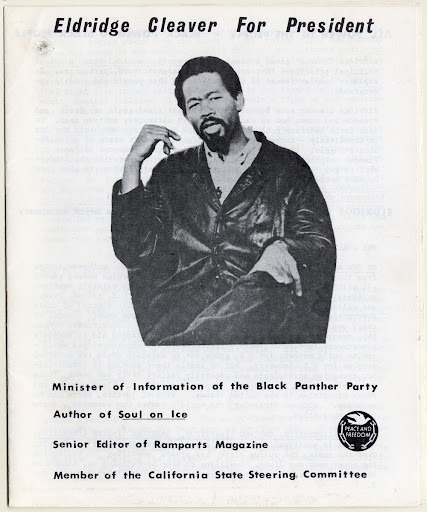
Ramparts was a hit-based magazine and needed a hot new story for every month. July 1965 was an interview with Hugh Hefner. It featured a foldout, but rather than a woman, they had Hefner himself (Keating turned his office into an imitation of Hefner’s after it hit newsstands). November was an attack on Reagan’s new autobiography penned by Mitford, anticipating his decision to run for governor. February 1966 was a special forces officer, Donald Duncan, who’d turned against the war and was attacking the CIA as its secret puppet master. But it was the April cover piece, readable here, that ultimately caused the CIA to assemble almost 400 separate dossiers on anybody who had anything to do with the magazine. A Michigan State University economics professor named Stanley Sheinbaum had been involved with a project to build the South Vietnamese government with secret support from the Agency. In secret, professors and students trained Vietnamese cops in fingerprinting, assisted Finance Ministry officials in accounting, and wrote the constitution from scratch for class credit. Concealed among them were CIA officers employed as MSU faculty engaged in torture and assassination, some of which Sheinbaum witnessed. The staff were sworn to secrecy except for Sheinbaum by clerical oversight, allowing him to tell his story. By April 18, the CIA had sprung into action. Director Raborn ordered an immediate file on the major staff members and a two month followup to identify every investor. This was technically illegal by dint of the 1947 law that created the CIA and banned it from spying on Americans, but the Agency had never actually adhered to that law anyways. It meant that the staff’s phones were under permanent wiretaps and virtually all of them would be audited yearly by the IRS. In July, the FBI followed suit, calling the magazine an agent of the Soviet Union. Both would engage in repressive action against Ramparts under the guise of COINTELPRO and MHCHAOS, illustrated by FBI man William Turner.
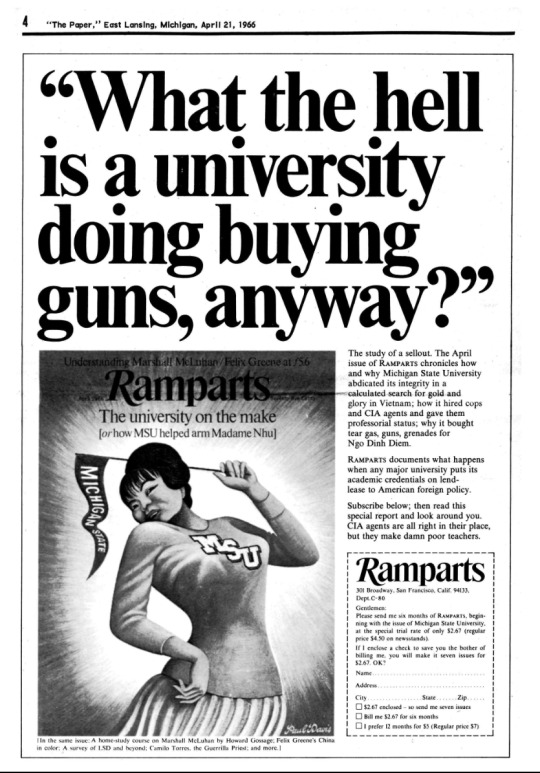
Turner was a 10 year Bureau veteran (Catholic, like most) who had become disillusioned after hearing Hoover call MLK “the most notorious liar in the country”. He was picked up by Ramparts, his first piece a critique of the FBI for a lack of convictions in attacks on civil rights campaigners. Turner became Ramparts’ muscle man, adding to stories through information gained from his connections with law enforcement across the country and helping to make lower level government investigations back off. Not long after he was hired, Turner was invited to the first of many parties at the offices. Also attending was Jessica Mitford and her husband, Robert Treuhaft, a lawyer who defended black southerners from the death penalty. Turner was introduced to them and immediately stated that he already knew them from somewhere, but they were sure he didn’t. It took him a few minutes to realize that he’d been listening to wiretaps of them from long before Ramparts even existed. Later, former Beirut Chief of Station Edgar Applewhite testified “I had all sorts of dirty tricks to hurt their circulation and financing. The people running Ramparts were vulnerable to blackmail. We had awful things in mind, some of which we carried off, though Ramparts fell of its own accord. We were not in the least inhibited by the fact that the CIA had no internal security role in the United States.“ His boss at the time, Desmond Fitzgerald, after being briefed on his recommendations said that he had blood on him. Louis Dube, who had experience dealing with drug-smuggling KMT guerillas in Burma, described what they’d done as “heady shit”.
Of course, this was a magazine run by drunken, drug-addled Irish Catholics with a penchant for spending work hours in strip bars and flying across the country holding lavish press conferences with old guard media men. It’s difficult to know where the sabotage ends and the incompetence begins. After Easter weekend 1967, Turner came into the office to find it ransacked with fire extinguisher goo and broken glass everywhere and a typewriter in the toilet. After months of searching, he finally found his culprit, a GOP official who’d committed the burglary for private right wing backers and then given photocopies to the CIA. He phoned up Hinckle, who immediately confessed to being the culprit. He’d trashed the office after a late night drinking session with Gene Marine, later the author of the first book on the Black Panthers. Not so, Turner said: the man he’d found had files from Ramparts’ storage. In fact, the burglar had done what he said, but nobody noticed the mess he’d made for two whole days in the general chaos of the workplace. It was a process repeated across many leftists groups in both macro and micro before and since.
46 notes
·
View notes
Text
Find the Word Tag
@hyba got me, thank you ^.^
I am leaving it OPEN! Your words, should you choose to search for them, are; warm, sharp, sky and blood
---
My words are night, touch, window and weight
Taken from Pale Blood. >.>
Night
Delmas was outside a bloodbank—Dolor’s only bloodbank—seething in the dim of a smog-black sky with his still-blinking netlink firmly hidden in the pocket of his duster.
“Halfnight ain’t my shift, Bosch,”He’d sneered into the device a mere hour prior, but his boss didn’t relent. Instead he reminded him of the cab waiting outside and the creds that paid for it—and the clothes on his back, and the apartment he seemed to value so highly just then. So Delmas traded warm blankets and worn sheets for filthy streets and choking smog.
Touch
Odea huffed at every one, or puffed rather, directly through their collected lights as she had no desires to tempt—flesh, though integral to the magic she so rarely tasted then, held no sway over her...as she cared little for touch.
With the sultry tones of Savor, her favorite netstar, singing from her netlink—glittering among the many other rings and charms decorating her ear—work was what mattered. All else be damned.
But, damned or not, else intruded.
Window
“Seriously, Ron, where are you? I’ve had a shitty start this halfnight and I need some answers before I lose my mind.” She was right outside the freezer. If he wanted to—which he decidedly did not—he could peek out the window in the door and see her standing there. “I was kidding about your ears. I won’t feed any part of you to my cats, I would never. I don’t know where you’ve been.” Ron laughed, it was short and more of a squawk but it was enough and Odea’s round face filled the window, fogging up her glasses as she spoke in a warbling singsong, “I see you.”
Her voice slipped too easily through the thick glass. It tickled chill fingers up his arms and burrowed into his ears and Ron wanted to run. But he was in a freezer. There was nowhere to go save under a shelf of blood bags or into one of the empty boxes meant for them. No matter how limber his dead limbs had proven to be, he knew damn well there was no way he’d be able to squeeze into a box that small.
So Ron sighed…and opened the door.
Weight (long one...cuz i wanna >.>)
Not once during their moaning bliss did Den bother to question if the room was paid for, but hearing it begged repeating, “The room’s paid up?”
Laying his head on his, Delmas mumbled, “Mm-hm.”
“And when did you have time for that?” Den’s voice threatened to hitch.
Delmas’ remained calm, and sleepy, “before the dancin’.”
While Den snipped, “Someone’s awfully confident.”
“Not really, jus’ figured, halfnight that bad, gotta be in for somethin’ amazin’…and there you were,” Delmas yawned again before adding, “kismet.”
Den did not swoon, but one could mistake the sound he made for one, “I’m the something amazing?”
Rubbing his hair into a bigger mess, Delmas nodded, “that you are.”
But his next yawn marked those his last words as soft snoring took over and Den squished beneath the full weight of the giant fang—weight that crashed against his muscles as it joined the lingering ache of their acrobatic meeting.
And soon he, too, drifted into sleep, with a smile at his luck—kismet, his thoughts sang—that the fang who saved his ass happened to have such a cute one of his own.
6 notes
·
View notes
Photo









Aston-Martin Vulcan
This is Aston Martin’s most intense and exhilarating creation ever, the 2016 Vulcan. Only 24 were built, this track-only Aston Martin, chassis number 15 of the 24 built, is one of the most exclusive automobiles in the world, capable of transporting extraordinarily fortunate souls into raptures of sound and fury unlike any other.
Developed in partnership with Aston Martin Racing, the Vulcan’s 820 HP naturally aspirated engine is based on that of their GT3 racer, but enlarged to a full 7.0 liters and electronically managed by Cosworth ECU technology. The Inconel and titanium exhaust system’s best feature comes during downshifts, when the side pipes crackle and pop while emitting flashes of blue flames. The Vulcan engine can be set at three output levels, allowing the driver to experience increasing power as his skill level improves with track time.
A lightweight torque tube encased in magnesium houses a carbon fibre driveshaft, which spins an Xtrac paddle-shifted 6-speed transaxle sequential gearbox. Sixth gear propels the Vulcan to a higher top speed than Aston Martin’s Le Mans GT3 racer, meaning well over 200 miles per hour.
Longtime Canadian partners Multimatic built the all carbon fibre tub using techniques learned from Aston Martin’s One77 program. It incorporates an integrated FIA-compliant all-steel roll-cage and a rear subframe designed to carry the transmission and rear suspension and handle the downforce generated by the rear wing. Speaking of downforce, the Vulcan generates more than it weighs at maximum speed – 3,002 pounds, to be exact, while maintaining stable aerodynamic balance front to rear under both acceleration and braking. The result is more predictable behaviour and more stable driver feedback, the better to become acquainted with the car’s fearsome grip, cornering power and agility.The Vulcan’s 4-way adjustable pushrod double wishbone suspension uses anti-dive geometry up front and anti-squat and anti-lift at the rear, with front and rear adjustable sway bars. Brembo 4-wheel Carbon Ceramic racing disc brakes are assisted by Bosch M4 motorsport driver-adjustable 11-position ABS. Michelin 305/30-19 front and 345/30-19 rear Pilot Sport Cup 2 tires are mounted on APP-Tech 10-spoke forged alloy center locking wheels finished in Satin Black and measuring 11.5-inches at the front and 12.5-inches at the rear.Passengers are secured in full carbon fibre Recaro racing seats that use Schroth 6-point racing harnesses and are Frontal Head Restraint System (FHR) Compatible (compliant to FIA specification 8862). The Vulcan also features an adjustable AP Racing Pedal box and a steering column adjustable for both reach and height. The bespoke carbon fibre steering wheel’s key function controls include the starter button, neutral, pit lane limiter, indicator, flash-to-pass, adjustable ABS and traction control, wipers and shift paddles. Driver inputs are supplied by a Cosworth Omega dash and Cosworth aliveDRIVE data acquisition system with in-car camera and USB data download port, ideal driver training tools that allow detailed analysis of laps over time or comparison to other drivers.
Aston Martin Design has outdone itself in shaping and detailing the Vulcan. Its prominent front splitter, rear diffuser and adjustable rear wing were all dictated by aerodynamics, but the shape is undeniably Aston Martin. The pronounced curves of the heated, anti-UV wraparound front and side screens dictated the use of IsoClima’s hard-coated Polycarbonate instead of glass, but it presents other benefits as well, being 50 percent lighter and 250 times stronger than glass and providing superior shatter resistance. Lighting is also extremely advanced. The LED headlights combine daytime running lights, directional indicators, main beam and side lights. Futuristic ‘Light Blade’ lamps introduced on the DP-100 Digital Concept Car are used at the rear along with an FIA-approved rain light positioned in the center of the diffuser. And for quicker pit stops, the Vulcan contains for on-board air jacks actuated by plugging an air hose into a fitting at the rear of the car.
70 notes
·
View notes
Text
oh yeah that one topic about in-universe vs real world interpretations of World Tour endings that i never actually posted
which i have now talked about in other reblogs so, im copy pasting what i had in case i left something out
~~ spoilers for World Tour's main story and ending~~
JP's remarks at the end of World Tour reflects his personality and character so well, this is just the start of it, and I must rant:
Echoing the Watsonian/ in-universe analysis, the fight is meaningless cause JP got what he wanted. Quite literally, the fight- the tournament- was just a cover for his money laundering operations, and whatever happened in the fight had no significance (to him at least).
(Aside: even though JP keeps dismissing fighting and tournaments as pointless, inefficient, or outright crude, he admits in his arcade mode to himself that despite the meaninglessness, he's starting to see the appeal, like Bison had. For the purpose of this post's rant though, it reflects his nihilism towards strength, fighting, and living. There's definitely more to be said about his personality here, but this is already getting so long I'll save it;;)
///
The fight against JP was also meaningless because your friend, your rival, the victim of his whole ordeal, Bosch, was still hurt and fails his mission anyway. Defeating JP and getting some 'revenge' isn't going to change the fact that our boy Bosch got exploded (he's probably fine I want him as DLC, he's gotta come back right. RIGHT??)
What's worse is that us, the Avatar, is partially responsible for causing this mishap: JP reveals to us that he only noticed and found out about the bomb in the champion's belt because we ran into him while trying to reinstall the safety on the bomb. In our efforts to save Bosch's life, we inadvertently tipped off a very astute enemy, and Bosch pays the price as a result. The whole fight means nothing cause JP had already seen through it all.
///
Finally to add to the option of the Avatar being able to ask JP to teach them as a master: I think it's implied that we demand power from JP explicitly to defeat him, and he knows this as well. There's a dialogue with him where he admits that he'd teach his techniques to even those who'd use that power to try and defeat him, and that he has no problem doing so. I'm not exactly sure if it's his own confidence that he wouldn't lose either way, or that he wants to see Psycho Power be wielded by likewise, strong and resolute individuals.
I think it works with his character though, since he believes power (and Psycho Power) to be a neutral force, only made morally 'good' or 'bad' depending on the user. He's willing to test other people with Psycho Power, and if they can defeat him, they've earned it, in a way.
///
AND NOW, for the Doylist/ real wrold view: I respectfully disagree that the devs would think Ranked was the only important part of the game!! World Tour is rather quite unique feature for the fighting game genre. It's a whole stand alone, single player experience that goes a lot, LOT further to develop the characters/ lore compared to most other fighters. And the avatar customization or skill set customization features with Avatar Battle in the Battle Hub also show just how integrated they wanted World Tour/ the story to be to other online, multiplayer aspects of the game.
Of course, I don't think many people are picking up SF6 just for World Tour, and I'm sure a lot of players simple will never play World Tour at all, period. But the fact that they still put in this entire narrative mode is amazing. And there's a lot of easter eggs/ references to the older games apparently as well, so to me that says it's a labor of love dedicated to both the devs and the fans :D
///
In terms of JP saying 'this is meaningless', if it has Doylist significance, I'd also agree it's along the lines of 'this is a video game, these fights are just made up for your entertainment. none of these stakes nor characters are real'.
But at the same time, I think they deal with some really relevant and contemporary issues in their story, such as:
• The rapid modernization of developing countries and its consequences on local history/ culture
• AI, deepfakes, and even cryptocurrency
• Capitalism™ need I say more
• Sensationalism in the news, rage/ fear bait content, turning everything into content and entertainment to be consumed by the masses
And at the center of it is JP, who is… in fact rather detached and dismissive of the whole affair. That seems a fitting representation of how all these issues don't 'care' about people on an individual, personal level, but are a product of a problematic, holistic system. As he says, he doesn't quite care what kind of person you are, as long as you don't get in the way of his plans. He's even willing to help you and give you the power you want, maybe knowing that we're playing into the same game he's playing.
Actually I do think he says something along the lines of this at max bond level too, how we've surpassed his own bloodlust and greed as we seek more power. Doylist wise, it definitely pokes at the game's own genre, literally being beating each other up for entertainment, albeit virtually. And of course, there's definitely players out there who don't take losses too well, complain and get salty, talk shit, end up on scrubquotes… Uh, anyway.
#jp rambles#some of the apathy stuff im repeating here#but the stuff about bosch i wanted to get out there#oh bosch........ ;-;
7 notes
·
View notes
Text
Extras Profile: Morton
One of the grand positives of “The Owl House” is that it devotes exceptional care to what I call the Big Three story elements: setting, characters, and - even more in the second season - plot. One facet of the characters is the truly incredible variety and creativity of the character design, stretching even to the background extras that keep popping up. Several of the characters, mostly at Hexside, have even been given semi-official names by the crew.
One of the early extras named in-series that has drawn my interest is Eda’s elixir dealer, Morton.

First appearing in “Hooty’s Moving Hassle,” Morton presents himself as an awkward and dorky alchemist/potionist who may not have a bunch of common sense given he spent all night poison tasting and wonders why he feels sick. However, at least to me, his earnestness is immediately appealing, as is his honest desire to help Eda, even if he doesn’t profit from it. This shows an unusual bit of integrity from one of the populace of the Boiling Isles. The fact that Eda calls him by name - and that he calls ner by a nickname, “E” - also implies that they’ve known each other for a while and that he owns the business Mr. Elixir - further evidenced by Morton’s cry for Eda’s release with “She helped me stay in business!”
Morton would continue to appear in the background of some episodes until “Keeping Up A-fear-ances,” where he refuses service to Luz without monetary payment - this and his desolation at a slow evening implying that Eda and Lilith are his main source of income. He next appears in “Elsewhere & Elsewhen,” where he appears as a guest at Hooty’s party thrown for Lilith to celebrate her new job. This implies that not only has he begun supplying Lilith with elixir for her curse, but he and Lilith have become acquainted enough for Hooty to consider them friends. Then again, he also invites Tinella Nosa, whom Lilith doesn’t seem to know, so he may have been stretching (Ha!) to fill the guest list. As of this post, this is his last major appearance.
Now for extrapolation and guesswork!
Morton’s job makes it almost certain that he’s a member of the Potions Coven. Simple and easy to figure. Though he aids and does business with wild witches, which is a real mark in his favor.
Given Eda’s proclamation as the “Most Powerful Witch on the Boiling Isles” and the fact that she was in the Potions track at Hexside, the fact that she doesn’t brew her own elixir stands out as strange. This is also noting that she, too, runs a small business selling potion - though this fact seems to have been forgotten after “Witches Before Wizards.” Eda even mentions to her mother knowing what goes into the elixirs. This implies early on that Morton actually brews the elixirs himself, which would further imply that he is remarkably talented in his field. Eda’s playful comment in “For the Future” about Lilith’s own elixir “putting Morton out of business” only adds credence to that idea.
Finally, an interesting note about his attire. Morton is always seen wearing a large funnel on his head like a hat. At first this seems like a quirky reference to his profession, but it may have a deeper meaning. In the time of Hieronymus Bosch - a Dutch painter whose surrealist works were a large influence on the look of the Isles and who has lent his name to two characters of the show - an upside-down funnel was a symbol of madness. Bosch himself used this imagery a few times in his works. Taken in context, one might think Morton is crazy - you know, for daring to do business with the Owl Lady despite her criminal background!
It really is a delight to find little tidbits about these background students that the crew has clearly put some thought into and stitch together a narrative. Had there been more time, I would have been happy to see more of Morton.
Thanks for reading! More to come …!
12 notes
·
View notes
Text
Who Was The Goddess? Or Goddess Who? Part 1: Lilith
So, I decided to bring here some discussions that I am raising in other media and that might interest people here! It's about witches, and witchcraft, and ancient goddess... I think it's quite nice!
I've noticed that there has been a growing interest in paganism, witchcraft, magic and mysticism, and it happens to be my research topic, so... I've decided to do a series about the myth of the Furious Horde (or Wild Hunt) and the goddesses that surround this mythology! Shall we?

Somewhere around in the 19th century - that is, from 1800 on - historians and anthropologists began to take an interested in the processes of witchcraft and sorcery that took place centuries before, back in 1500, 1600, and some of them raised the hypothesis that those accused people were performing much older cults and rituals, from a pre-Christian era and that they would have survived until that time. In particular, those people would be worshipping some pagan goddess and that this would have been the final straw to turn this "goddess" and her followers into witches. But what about today, can we also come to these conclusions or even find this "goddess" and her cult?
And as the candidates are many, I will talk here one by one!
Lilith
She is not only a pagan goddess, and a very strong candidate, but she is growing popularity to this day.
So back in Mesopotamia, around 2000 B.C. we find a category of demons, male and female, which were called "Lil". They were erotic demons that invaded the dreams of both men and women, and in the course of time they were also represented as a danger to pregnant women who were giving birth. A Phoenician text from the 7th century B.C. tells of an exorcism of a "flying Lili in a dark chamber".
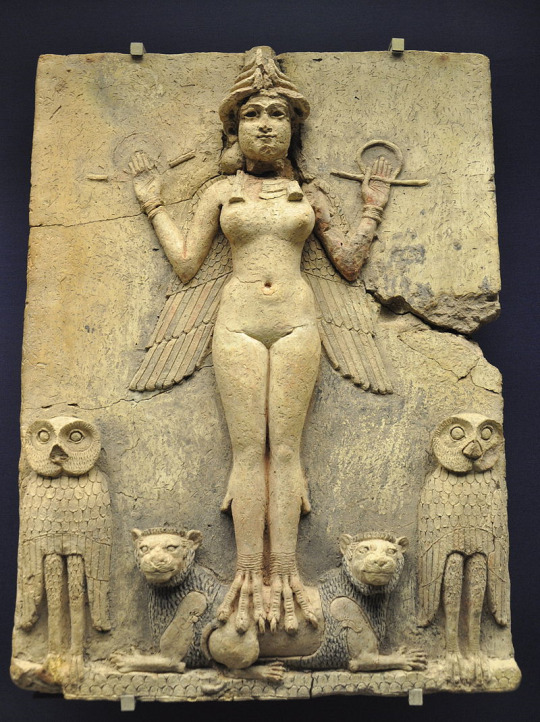

And even in the Hebrew Bible there is reference to a Lilith in Isaiah 34:14, which says:
Wildcats shall meet with hyenas, goat-demons shall call to each other; there too Lilith shall repose, and find a place to rest.
It's interesting that I found a website that says it translates the Bible straight from the Hebrew, and in that passage they translate "Lilith" as "ghost," and then if you go into the description of the term, they put lîylîyth (lee-leeth')
- "Lilith", the name of a goddess known as the demon of the night who haunts the desolate places of Edom
- It could be a nocturnal animal that inhabited desolate places
So at this point this “Lilith” is still this demon or just a nocturnal creature, that was flying around like a bird haunting people's dreams (save this information for the future).
This fear of the liliths, or the lilin remained in this region of the Middle East until after Christ, and we can find some representations of what these female demons would look like: a naked young woman, with long flowing hair and with her breasts and genitals prominent; it was the aggressive and animalistic sexuality, the opposite of what female behavior should be.

Alphabet of Sirach: anonymous medieval text; compilation of two lists of proverbs, 22 in Aramaic and 22 in Hebrew, both arranged as alphabetic acrostics
But in the 8th century, in the Jewish text the Alphabet of Sirach, Lilith for the first time appears not as a category, but as a proper name, a unique being. She would be Adam's first wife and became integrated into Hebrew mythology. God would have created Adam and Lilith at the same time, but she would not have accepted to submit to Adam, since both had been created together and in the same way.

Hieronymus Bosch, The Garden of Eden. Left panel from The Garden of Earthly Delights. 1504, Madrid, Prado.
Upon realizing that Adam would not give up, Lilith flew to the Red Sea, where she met several demons and joined them, generating an offspring of more than 100 demons a day. Adam then allegedly went to complain to God about Lilith's escape, and God even sent angels to bring her back, but in vain. In her fury, Lilith would have promised to wipe out all of man's offspring as revenge. From then on, she became one of the most feared demons in Jewish culture, with the fame that she was responsible for the sickness and death of babies, especially unbaptized ones.


Throughout the Middle Ages and the modern period, this story became very popular first among the followers of the Kabbalah, but quickly spread and began to populate the stories of Christians as well.

Eve and the serpent de Vérard 1493-1494, Le Mirouer de la Redemption de l'umain lignage Paris: Vérard, fol. 2v
But we do not find, throughout the Middle and Modern Ages, any evidence of any kind of cult dedicated to her, or indication that she could be seen in any positive way. Everything we find related to Lilith are actually spells of protection against this demon, so they are spells of mothers protecting their children, or spells for women in childbirth, i.e., seeing Lilith really as a demon that people should protect themselves from.
But nowadays Lilith has gained a new prominence not as a feared demon, but as the representation of a woman who did not accept to submit to the will of man and went out in search of her own story.

Sources: Ronald Hutton, " The Witch: A History of Fear, from Ancient Times to the Present”. Yale University Press, 2017
Hilário Franco Júnior, "A Serpente, espelho de Eva. Iconografia, analogia e misoginia em fins da Idade Média" ( The serpent, mirror of Eve. Iconography, analogy and misogyny in the end of the Middle Ages). Medievalista, Number 27, 2020.
#witch#witchcraft#witch community#pagan#lilith#nature magic#naturemagic#witchcraft history#demonology#history#education
23 notes
·
View notes
Text
What To Do During the Strike, Day 7
*
So, mystery.
When I started writing, I quickly gravitated toward mystery. It can be a beautiful genre that balances firm structure with plenty of embroidering. It's like Bach, but in story form -- you have the concatenations marching through the piece, laying the groundwork for the flights of fancy.
youtube
If you want to comment on the human condition in the stories you tell, they had best have a strong framework. Sir Terry Pratchett was the master of this. You will note, though, that Discworld was a fully realized setting, that the characters were both three-dimensional and with very clearly defined roles, and that the plots usually marched forward in generally predictable ways. The story was solid. His commentary on people, justice, integrity, and the human condition then was interwoven throughout.
With a mystery, you also have a plot driven story. Something happens, other things follow in pretty predictable ways, and there is eventually a conclusion. As a writer, the plot carries you. It marches. It holds to the center.
Now the basic murder mystery approaches are typically "police procedural" or some kind of "private detective" (professional or amateur). Agatha Christie notably had some one-offs that did not fit well into categories, but she was an exception. These days, what is being sold is usually one or the other.
I started studying Connelly because of his popularity, but I became fascinated by his commentary. The structure was there, and as a crime beat writer, he had the technicals of a police procedural down cold -- but he named his first main character after a 15th century Dutch painter known for his nightmarish and bizarre depictions of Hell?
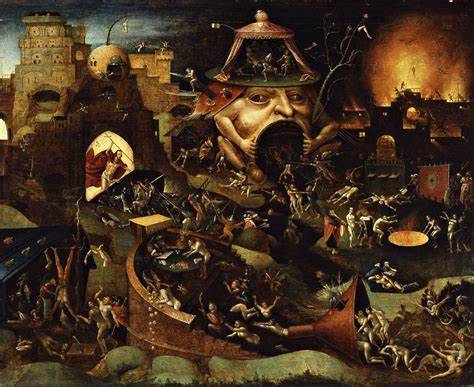
Well, I'll be damned, this man was trying to say something. And yes, I get it -- cops see hell. His character Harry Bosch had seen hell before, too, particularly in the jungles and tunnels of Vietnam in war.
And here is where it gets interesting. You might not be all that enthused to read about police right now. God knows, we have a lot going on in the press and our recent US history that makes inhabiting the mind of a cop, well, to sound perfectly unpalatable. (And this was how I felt anyway, back in my 20's -- it just did not appeal. I'd seen too much in the South.)
However, Connelly will not fail you. Bosch has, at his core, an implacable moral code expressed as "Everybody counts, or nobody counts." Goddamn. That's the categorical imperative from Immanuel Kant. This mystery writer is doing interesting things.
The categorical imperative has about five different (but linked) formulations. The second formulation (the "formula of humanity"/ the "formula of the end in itself") is most applicable to Bosch's code: Act in such a way that you always treat humanity, whether in your own person or in the person of any other, never simply as a means, but always at the same time as an end.
Kant makes the argument in the 1785 Grounding of the Metaphysics of Morals that every rational agent has his or her own goals, desires, and projects -- and that none of these are more important than any other. In fact, insofar as one can, we are all beholden to further the projects and interests of others as if they were our own. They count just as much as ours do.
All of us are ends in ourselves, acting as agents in the kingdom of morality, and we should never be treating others as a means only to our own ends.
"Everybody counts, or nobody counts."
Bosch is a complex character, both flawed and failing at times. But he never, never would have put a knee to George Floyd's neck, and he would not have let a fellow officer's actions in the manner go without pursuit for justice.
Police work is never going to be pretty and clean. Sometimes you see the depths of the human condition in the state of hell. But can you write a character that walks through a slime pit of moral decay with a moral code maybe tarnished, but still intact?
I think you can. I think that was Connelly's main project in writing this character. Now, he went on to develop other themes and characters (you probably know about The Lincoln Lawyer), but there were about 20 Bosch novels. Consider reading them. He does interesting things with the characters as well, but that's for another piece. For now, if you want a police procedural that can cleanse your palate of some of the recent terrors, you might start with The Black Echo.
-------------------------
Next up, poetry.
2 notes
·
View notes
Text
Top Wholesale Surveillance CCTV Camera Brands in India

In India, the demand for surveillance CCTV cameras has been steadily increasing due to the growing awareness of security needs in both residential and commercial settings. With numerous brands competing in the market, let's explore some of the top wholesale surveillance CCTV camera brands in India:
Hikvision: Hikvision is one of the most well-known and trusted brands in the surveillance industry. They offer a wide range of CCTV cameras, including IP cameras, dome cameras, bullet cameras, and PTZ cameras. Hikvision is known for its high-quality products, advanced features, and reliable performance, making them a popular choice for wholesale purchases.
Dahua Technology: Dahua is another prominent player in the Indian surveillance market. They are recognized for their innovative solutions, such as AI-powered cameras, thermal cameras, and advanced video analytics. Dahua's products cater to various industry needs, making them a preferred option for wholesalers and system integrators.
CP Plus: CP Plus is an Indian brand that has gained significant popularity in the surveillance domain. They offer a wide range of cameras, including HD cameras, IP cameras, and wireless cameras, along with DVRs and NVRs. CP Plus focuses on affordability without compromising on quality, which has contributed to its success in the wholesale market.
Bosch Security Systems: Bosch is a global player with a strong presence in the Indian market. Their surveillance cameras are known for their durability, advanced technology, and seamless integration with other security systems. Bosch caters to various applications, from small businesses to large enterprises.
Evoke Hi Tech: Evoke Hi Tech is a renowned brand in the electronics industry and has a significant share in the surveillance camera market. They provide high-resolution cameras, low-light cameras, and advanced PTZ cameras suitable for various surveillance needs. Evoke Hi Tech's cameras are preferred for their image quality and reliability.
Samsung: Samsung, a well-known consumer electronics brand, also offers a range of surveillance cameras in India. Their cameras come equipped with advanced features like digital image stabilization, thermal imaging, and smart analytics, making them an attractive choice for wholesale buyers.
Honeywell: Honeywell is a global conglomerate with a strong presence in the security and surveillance sector. They offer a diverse range of CCTV cameras, including dome cameras, bullet cameras, and panoramic cameras. Honeywell's cameras are known for their rugged design and cutting-edge technology.
These brands have earned their reputation in the Indian market by consistently delivering high-quality, reliable surveillance solutions. When purchasing wholesale CCTV cameras, it's essential to consider factors like camera type, resolution, lens options, and additional features to ensure they meet specific security requirements.
#CCTV cameras#CCtV#cctv camera#cctvsecuritycameras#cctv systems#cctv footage#Gale tech#Technology#surveillance
3 notes
·
View notes
Text
it’s so funny to see people lose their shit over the dude using ai to extend the landscape of the mona lisa and starry night or whatever, and appealing to some kind of artistic integrity as if they are not two of the absolute most parodied artworks in the world with one billion tacky as hell reproductions.
i have 0 investment in ‘defending’ the dude who posted them or whatever, but people losing their mind over how ‘inferior’ the ai reimaginings are are putting too much stock in how serious this guy is about it. idk i think it’s just an exercise in seeing how a computer calculates averages to extend a landscape and see what weird stuff pops up. i don’t think hieronymus bosch will be offended
#companies will try to replace workers with ai that’s true but that is a result of capitalism babey not an inherent evil on the part of ai#sometime’s it’s funny to see what the machine produces
2 notes
·
View notes
